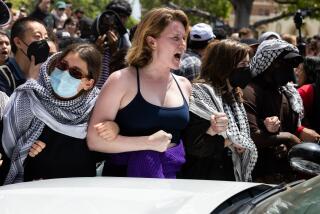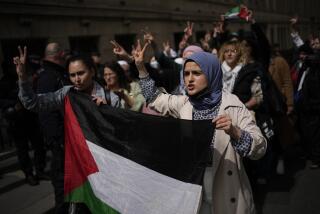Month of Protest Is a Knife Blade in French History : After 1968 ‘Events of May,’ Life in France Was Never the Same
PARIS — May 3, 1968.
It began as any other Friday in Paris. People headed for work with no idea that by nightfall blood would be in the streets, that students would battle police in an insurrection destined to shake French society to its roots.
“1968 was a cultural revolution in every sense of the word. Afterward, nothing was the same,” said Regis Debray, then a radical and today an adviser to President Francois Mitterrand.
The monthlong series of strikes, protests and pitched battles nearly brought down the 5th Republic of President Charles de Gaulle. He resigned the next year.
Two decades later, historians call May, 1968, the greatest popular uprising ever experienced by a capitalist democracy in time of peace. The Events of May, as they are called, still reverberate in French minds.
Knife Blade in History
Politics, schools, family life, work, art and popular culture were transformed. May, 1968, was a knife blade that severed past from future, youth from authority, then from now.
When the tear gas cleared, a new libertarian tolerance was in the wind and the twin political pillars of Gaullist nationalism and communism were permanently fractured.
“It was a revolution in the way we live,” Debray said, “a transition from an old, rural France where everyone had great respect for central authority toward a modern, urban France of more liberal individualists.”
The spasms of unrest in France were part of a common impulse felt by a global generation, the affluent postwar children who, from Berkeley to Berlin, focused their anger to protest U.S. involvement in Vietnam, the former French colony.
Today’s French Leaders
Today, many of these angry young men are leaders of French society.
The flash point of the Events of May was the suburban campus of Nanterre, where protests the preceding March had led to the closing of the school.
On May 3, about 500 students staged a sit-in at the Sorbonne, the old and respected university in Paris, to protest disciplinary action at Nanterre. By late afternoon masses of riot police had surrounded the Sorbonne and began making arrests.
Students poured from Latin Quarter cafes with shouts of “liberez nos camarades!”-- free our comrades.
Fighting began.
A frantic administration shut down the Sorbonne, for only the second time in 700 years.
Weeklong Violence
A week of shocking violence followed. Students erected barricades of buses, felled trees, benches and streets signs. They tore cobblestones from the streets to hurl at police.
Riot police clubbed students and chased them through narrow streets, sometimes blocking medical help to the injured. Stinging clouds of tear gas shrouded Left Bank neighborhoods.
By mid-May the brutality had swung public opinion behind the students.
Writer Mavis Gallant, in her recently published diary, described the morning after a violent clash that injured 367 students:
“Ripped streets around the Luxembourg Station. People who live around here seem dazed. . . . Paving torn up. . . . Where I used to live looks bombed. Burned cars, ugly, gray-black. . . . Armed men and unarmed children. . . . We all feel sick.”
Burning Image
Marc Kravetz, a leading student figure on the barricades and now foreign editor of the newspaper Liberation, said the burning car is the single image of the street fighting that endures in French minds.
“The car was the symbol of middle-class achievement,” he said. “And bourgeois values were going up in smoke.”
More than 1 million people formed a river of flags and banners pouring down Left Bank boulevards on May 13, and reports of demonstrations came from college towns across France.
Then, something even more astonishing happened.
9 Million on Strike
In a spontaneous wave that swept the nation, more than 9 million people went on strike.
Normal life in Paris came to a halt. It was impossible to buy a newspaper, go to school, send a letter, cash a check, ride the bus or subway, watch television or take a train. Frightened people, who remembered World War II, began hoarding cigarettes, sugar and canned goods.
The difference between the strikes at Columbia University in Manhattan and the Sorbonne in Paris was that the rest of New York City barely noticed what was happening uptown at Columbia. Paris was paralyzed.
Garbage piled up in the streets. Teachers stopped teaching, actors stopped acting. The Odeon Theatre was occupied by students and workers holding marathon debates on creating a new society. Even rugby players went on strike.
Communist Party Doomed
The strikes marked the beginning of the end for the Communist Party, which sabotaged the student movement, believing it an uncontrollable revolt of spoiled middle-class kids. But that attitude permanently alienated intellectuals and youth and contributed to the eventual election of a Socialist president, Mitterrand.
More significantly, French politics had to deal with a new force--the media. Young people came to view television, radio and newspapers as not just reporters of events, but tools for the creation of events.
Debray said one such creation was Daniel Cohn-Bendit, the best known of the radical student leaders, called Danny the Red because of his rusty hair and provocative style.
“It was not Cohn-Bendit who organized the rallies or did the concrete work,” Debray said. “But he was the one the television cameras loved, so, whether he wanted to or not, he became a major leader of the movement.
“1968 was the beginning of the media’s conquest of French politics and life.”
End of Traditional Politics
Young people realized that all they needed to be effective was just 2 minutes on the evening news.
“We stopped thinking in terms of traditional politics,” said historian Herve Hamon, once a student on the barricades and now author of a history of the 1968 generation.
Hamon said that as his peers grew older, they rejected politics to pursue careers in medicine, teaching, the arts and, above all, journalism.
Cohn-Bendit, born in France of German parents, now publishes a current affairs magazine in Frankfurt, West Germany. At 43, he still lives the life of a free-lance radical, writing books and working with West Germany’s anti-Establishment Greens Party.
Long-Term Effects
“I believe I can still legitimize everything I do from my standpoint in 1968,” Cohn-Bendit said, adding that events 20 years ago irrevocably changed morality, sexuality and French education.
Alain Peyrefitte, who as De Gaulle’s education minister in 1968 considered Cohn-Bendit a troublemaker, now agrees with his assessment of the events.
“I was against the movement and felt it was my duty to limit it at the time. But I recognize that in the long-term the effects were good,” said Peyrefitte, now head of the editorial board for the conservative newspaper Le Figaro. “People became more responsible for their lives, gained more dignity and felt more free.”
On May 30, De Gaulle made a long-awaited radio speech, reassuring French citizens, who were fed up with upheaval, that the government was in control. Hours later, millions of Frenchmen jammed the Place de la Concorde, waving the French flag. The nation cooled down as abruptly as it caught fire.
Series of Reforms
Under De Gaulle, a series of reforms came in late 1968 to decrease the number of students in a classroom, increase personal contact between students and professors and decentralize the control of schools.
1968 opened the door for the French feminist movement in the 1970s and the introduction of legal reforms governing abortion and contraception. Relationships between men and women changed.
The students of the barricades now are graying parents, and relationships between these fathers and sons are less formal, more tolerant.
“In the marches of ’68 you never saw any parents,” Kravetz said. “In 1986, in the demonstrations against the education reforms, parents marched beside their kids. There is greater communication between the generations now.
“To understand what 1968 meant to us, you would have to have seen what we were like before.”
More to Read
Sign up for Essential California
The most important California stories and recommendations in your inbox every morning.
You may occasionally receive promotional content from the Los Angeles Times.










